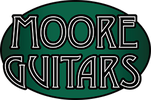Bracing
Inside every Taylor guitar is an important source of its unique sound: bracing. Bracing exists to strengthen the top and back of the guitar, while also allowing enough flexibility and vibration to generate tone. Bracing patterns help “voice” a guitar.
Taylor guitars are known for their balanced tonal response, and our bracing plays a role in that. The way that each brace is shaped and positioned on the soundboard contributes detailed nuances that are so critical that even slight alterations of its design, profile or thickness can result in discernible differences in tone.
V-Class Bracing
Our patented V-Class bracing is a revolutionary new pattern that marks a major shift away from traditional bracing techniques. It brings a new voice to the Taylor acoustic guitar line by changing the way the top vibrates. By allowing the soundboard to flex naturally while maintaining rigidity along the center (in the direction of the strings), V-Class bracing helps produce more volume and sustain. It also creates a more orderly response from the soundboard, improving the intonation by putting all the notes more in-tune with each other. Up and down the fretboard, the notes are full, true and consistent, with more harmonic agreement. For players, these improvements bring more expressive range and allow the unique tonal flavors of the guitar’s tonewoods to shine.
Learn more about V-Class bracing.
X Bracing
All of Taylor’s bracing for steel-string models is a form of X bracing. The “X” provides a continuous flow of strength from the upper bout to the lower bout, which provides rigidity in spite of the soundhole’s location in the middle of the soundboard. We currently offer several versions of X bracing:
Classic X (used on layered wood models)
This is Taylor’s original X pattern, featuring scalloped braces. Classic X bracing is used on the Baby, Big Baby, GS Mini, Academy, 100, and 200 Series.
Performance (used on the 300, 400, 500, 700, Koa Series)
Customized by body shape, Performance Bracing is grounded in the X-brace tradition with modifications that allow for subtle adjustments in brace shape and placement to influence how the top moves in relation to the back and sides. The design features a two-part bridge plate, resulting in a louder, more powerful tone.
Advanced Performance (used on the 600, 800, 900 Series)
As part of Taylor’s 2014 voicing refinements for the 800 Series, the bracing profiles and placement were customized for each body shape to optimize their inherent strengths. The bracing scheme also incorporates side braces, which add rigidity and help maximize top and back movement. The overall effect on all the shapes is greater warmth, midrange and sustain.
CV with Relief Rout (used on the Presentation Series)
CV Bracing incorporates Taylor’s proprietary relief rout, permitting greater top flexibility and in turn, projection. Additional refinement comes from contouring the scalloped braces, which adds sustain and delicate articulation to each CV-braced guitar. In general, guitars with CV bracing sound fuller and fatter without giving up articulation. They are also slightly louder.
The Taylor Relief Rout
Our patented relief rout is a tone-enhancing voicing technique in which a groove is carved along the inside edges of the top. This groove is similar in function to the re-curve on a violin — it “loosens up” the edges of the top, generating extra flexibility without sacrificing structural integrity. We first began using this groove in 2002. The result is increased bass and volume with a balanced tone.
Nylon-String Fan Bracing
Fan bracing is a completely different bracing style that is used on our nylon-string models. It was inspired by patterns used by classical guitar builders. Because nylon strings generate less tension, a nylon-string guitar typically has a thinner top and much lighter bracing. Our unique ladder-style pattern produces a signature Taylor nylon-string voice: an “open” sound that’s clear and bright, strong on the treble side, and long on sustain.



